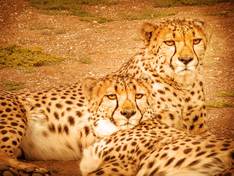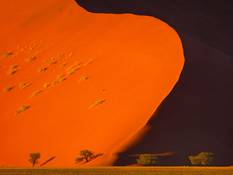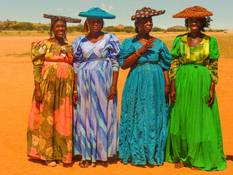Namibia Tour
This tour leads you through the wonders of a spectacularly beautiful country along the south-west coast of the African continent: Namibia. Discover the big highlights of one of the least inhabited countries of the planet - in the midst of breath-taking landscapes and unforgettable impressions. The seemingly endless deserts of Namibia are part of the most rewarding travel destinations in Southern Africa. The colours of the Kalahari, the second biggest canyon in the world, the mighty Fish River Canyon, spectacular mountain sceneries and the tall red dunes of the Namib Desert are part of a fantastic setting of this journey through Namibia. The feeling of endless freedom, the friendliness of the local people as well as the remnants of the former German colonial time will leave everlasting impressions on you. Travelling in a small group size, our highly experienced, knowledgeable and qualified tour guide will lead you in a comfortable air-conditioned bus on this exclusive 17 day round-trip through Namibia, where you will encounter people of the most diverse backgrounds and cultures, many animals of the African bush and everlasting impressions of a country like no other.
Tour Highlights
- comfortable travelling in a small group size with a very experienced and qualified tour guide
- The world renowned Etosha National Park
- The mysteries of the San Bushmen
- Namibia's own "Matterhorn" - The Spitzkoppe
- The red dunes of the Namib Desert
- The second biggest canyon in the world - Fish River Canyon
- The "most German town outside Germany" - Swakopmund
- The endless horizon of the Kalahari Desert
- ...and much more!!!
Tour Description
Day 1: Departure towards Namibia
Your trip starts with your flight to Windhoek, Namibia.
Day 2: Welcome to Windhoek, Namibia
Arrival at Windhoek International Airport where your tour guide will welcome you. Our first destination is a wonderful game farm just outside Namibia’s capital. After freshening up we will go on our first safari in an open game drive vehicle. With a bit of luck we might spot antelopes, zebras, giraffes or even rhinos and lions. 78 km / D
Day 3: Along the historical Waterberg
After breakfast we will head in a northerly direction and after a three hour trip will arrive at the famous Waterberg plateau, an impressive table-top mountain rising 200 meters above the surrounding area. In the afternoon we will embark on an easy walk to the top of the plateau to enjoy the fantastic views from there. We can always shorten the route to our liking too. In the evening we will enjoy dinner in the park's restaurant before settling into our comfortable bungalows at the foot of the Waterberg. 259 km / B, D
Day 4: The Etosha National Park
In the morning we will embark in a north-westerly direction to the entrance gate of the world renowned Etosha National Park. En route we stop at the old mining town of Tsumeb to visit the fascinating Tsumeb Museum, where we will get a chance to glimpse at the history of Namibia, from the early San Bushmen through the colonial areas to modern history. After another stop at the interesting Otjikoto Lake we will reach the park's entrance. After formally checking in we will reach our beautiful chalets in the middle of the park, surrounded by Mopane trees and the sounds of the African bush. This will be our home for the next two nights. For dinner the camp boasts a nice restaurant with good game dishes. 472 km / B, D
Day 5: The Etosha Pan
This 22,275 square kilometres nature reserve is one of the most important national parks in the country. Etosha is situated on the north-western edge of the Kalahari Basin and covers almost the entire 5,000 square kilometres Etosha Pan. The name “Etosha” derives from the Oshivambian language and means “great white place”. The Etosha National Park is home to a huge variety of big game species. If conditions are favourable, we should encounter many of the 114 mammals, 340 birds, 110 reptiles and 16 amphibian species. After safari trips in our own vehicle we return to the rest camp where the pool in the middle of the camp offers a welcome refreshment. The flood-lit waterhole provides ideal night-time entertainment. 399 km / B, D
Day 6: Twyfelfontein
We will spend the morning in the park driving, in a southerly direction, to spot more animals along the way before leaving the park through the Andersson Gate at about lunch time. We will have a quick break in the tiny village of Outjo before arriving in Twyfelfontein in the afternoon. There we will be staying in a beautiful lodge in a stunning setting of surrounding rocks and mountains. The buffet dinner here is legendary. 411 km / B, D
Day 7: From Ancient rock engravings to
the Atlantic Ocean
In the morning we will have time to visit the world famous bushman paintings, just a few kilometres away from the lodge, where a guide will take us on a 45 minute tour around this truly amazing setting in the middle of nowhere. We will learn a great deal about the San Bushmen and their former way of life. The site has been inhabited for 6,000 years, first by hunter-gatherers and later by Khoikhoi herders. Both ethnic groups used it as a place of worship and a site to conduct shamanist rituals. In the process of these rituals at least 2,500 rock carvings and paintings were created. UNESCO announced Twyfelfontein as Namibia's first World Heritage Site in 2007 as it is home to one of the largest concentrations of rock petroglyphs in Africa. After lunch we will make our way to the rough Atlantic Coast, where we will visit the Cape Cross. In 1486, the celebrated Portuguese seafarer and explorer, Diego Câo, erected a padrâo, which is a stone pillar topped by a cross, establishing his country's claim to the territory. He was searching for a sea route around Africa to India. The cross became a landmark and an important 15th century navigational aid known as 'The Cabo de Padrâo' and eventually Cape Cross in English. It was on the authority of the then German Emperor, Wilhelm II, that a replica should be made and re-erected, eventually only 15m from the original placing on 23 January 1895. The original eventually ended up in the German Museum for Technology in Berlin. We will also visit the best-known breeding colony of Cape fur seals along the Namib coast, where the population has grown large and fat by taking advantage of the rich concentrations of fish in the cold Benguela Current. The sight of more than 100,000 seals basking on the beach and frolicking in the surf is impressive to behold, though you’re going to have to contend with the overwhelming odoriferousness of piles and piles of stinky seal poo! Afterwards our drive will take us to the nearby coastal town of Swakopmund where the cold Atlantic Ocean meets the hot Namib Desert, a spectacle like no other. A charming guest house in town will accommodate us for the next two nights. 384 km / B, D
Day 8: A day in Swakopmund
Today Swakopmund invites you to relax and enjoy the “most German town outside Germany”. The former German colonial town boosts with beautiful architecture and good shopping opportunities in a variety of boutique shops. Swakopmund has approximately 44,000 inhabitants, where 5% are direct descendants of German origin, which has had a huge impact on the town. The jetty leading out to the Atlantic Ocean is ideal for a leisurely stroll where we can soak in the crisp air that surrounds Swakopmund. Alternatively additional trips can be arranged for today, for example a boat excursion with the famous MolaMola Tours to visit a seal colony in Walvisbay or an exciting trip on quad bikes into the dunes of the Namib. These excursions must be booked in advance and are not included in the tour price. For dinner we enjoy one of the best seafood restaurants in town. 0 km / B, D
Day 9:
Over the Tropic of Capricorn to
the Namib Desert
In the morning we depart in an easterly direction and travel through the rocky part of the Namib Desert. After two thrilling passes through the spectacular Kuiseb and Gaub Canyons we cross the Tropic of Capricorn, where we will take some pictures. We continue our trip to the edge of the Namib Desert where a gorgeous lodge nearby the main entrance to the Namib Desert awaits us. Here we will be staying for the next two nights. 134 km / B, D
Day 1
0
: The red dunes of the Namib Desert
Today we rise early because we will drive to witness the sunrise over the Namib Desert, a fantastic display as shadows cast on the clear edges of the red sand dunes. The name Namib is of Nama origin and means "vast place". The Namib stretches for more than 2,000 kilometres along the Atlantic coasts of Angola, Namibia, and South Africa, extending southward from the Carunjamba River in Angola, through Namibia and to the Olifants River in Western Cape, South Africa. From the Atlantic coast eastward, the Namib gradually ascends in elevation, reaching up to 200 kilometres inland to the foot of the Great Escarpment. Annual precipitation ranges from 2 millimetres in the most arid regions to 200 millimetres at the escarpment, making the Namib the only true desert in southern Africa. Having endured arid or semi-arid conditions for roughly 55-80 million years, the Namib is also the oldest desert in the world! Daily temperatures can range from 0 degrees at night to 50 degrees in the day and yet there are still many animal and plant species that survive in these harsh conditions. Today we will visit the famous 140 meters tall Dune 45 and take walk to the Dead Vlei, a huge dried up pan with dozens of dead camel thorn trees, that died many hundreds of years ago and now give some breath-taking photo opportunities. Afterwards we will visit the next highlight of the Namib Desert, the Sossusvlei. The name "Sossusvlei" is of mixed origin, and roughly means "dead end marsh". "Sossus" is Nama for "no return" or "dead end". Sossusvlei owes this name to the fact that it is a drainage basin without outflows for the ephemeral Tsauchab River. In the afternoon we will drive to the Sesriem Canyon. On a short walk down the canyon we discover how the seldom flowing Tsauchab River has cut his way through several impressive layers of rock. A fantastic dinner awaits us that the evening back at the lodge. 82 km / B, D
Day 1
1
: En Route to Aus
After breakfast we will leave the lodge in a southerly direction, driving parallel to the Namib Desert over the rather impressive Tsarishoogte Pass. After a lunch break in the tiny German colonial village of Helmeringhausen we will reach the town of Aus in the southern region of Namibia. West of Aus one sees the dunes of the Namib Desert. We hope to spot some of the mysterious Namib Desert Horses, a rare feral horse found here in the Namib Desert. It is probably the only feral herd of horses residing in Africa, with a population ranging between 90 and 150. Despite the harsh environment in which they live, the horses are generally in good condition, except during times of extreme drought. The horses have been the subject of several population studies, which have given significant insight into their population dynamics and ability to survive in desert conditions. The origin of the Namib Desert Horse is unclear, though several theories have been put forward. Genetic tests have been performed, although none to date have completely verified their origin. The most likely ancestors of the horses are a mix of riding horses and cavalry horses, many from German breeding programs, released from various farms and camps in the early 20th century, especially during World War I from the German Schutztruppe. In the late afternoon we will check in at our beautifully situated lodge close to the town of Aus with a view that seems to go on forever and mind boggling star lit skies. 344 km / B, D
Day 1
2
: The second biggest canyon of the world – Fish River Canyon
We continue our trip further south today and drive to one of the most spectacular sights in southern Africa – The Fish River Canyon. After the Grand Canyon in America, the second biggest canyon of the world lies in seemingly barren wilderness of vast inhospitable rock and sand terrain. The 160 km long, 27 km wide and up to 550 meters deep Fish River Canyon is somehow one of the least-visited of nature’s secret wonders in the solemn magnitude of desolate, daunting and awesome landscape sculpted by millions of years’ exposure to the elements. On a short 4 kilometre walk along the edge of the canyon we will watch this awesome sight in the warm colours of the afternoon light, displaying a fantastic array of colours and formations. Not far from here we will be staying in a beautiful lodge for the next two nights. 285 km / B, D
Day 1
3
: A days
trip to the hot springs of Ai-Ais
On our today’s trip we will travel to the area of Ai Ais, the end of a famous 5 day Fish River Hiking Trail. From here we can take a leasurly walk upstream along massive rock formations to discover this stunningly beautiful area where we might encounter rock hyrax, springbok, kudus or zebras. The National Park of Ai-Ais boosts a beautiful hot springs pool where we can relax in the afternoon in a most significant setting of rocks and mountains before returning to our lodge. 154 km / B, D
Day 1
4
: The vast Kalahari
After breakfast we leave this area in a north-easterly direction to travel to the famous quivertree forest, another huge attraction of the southern parts of Namibia. Close to Keetmanshoop, we discover about 250 of the tree aloes, that were declared a National Monument in 1995. The Quivertrees grow up to 8 meters tall and were used by the San Bushmen, who hollowed out the branches to use them as quivers for their arrows. Continuing our drive in a northern direction we will reach the vast 1.2 million square kilometres Kalahari desert in the afternoon. Covering much of Botswana and parts of Namibia and South Africa, the Kalahari is a semi-desert, with huge tracts of excellent grazing after good rains and supports more animals and plants than a true desert, such as the Namib Desert to the west. There are small amounts of rainfall and the summer temperatures can soar up to 40 degrees. Here we will be checking into our comfortable lodge, which is part of a 10 000 ha conservation area overlooking the vast plains of this magnificent area. 423 km / B, D
Day 1
5
: A gorgeous morning hike and back to Windhoek
Ancient red sand dunes and a unique vegetation with hundreds of years old camel thorn trees, grass bushes and animals will set the location as we depart in the morning in a northern direction to reach the starting point of this tour, the capital of Namibia, Windhoek. After an orientation-drive through this city of 320,000 inhabitants and a visit to some of the interesting sights, such as the old German church, the Christuskirche and the Alte Feste, we will check into an elegant hotel in the middle of town. In the evening we will reflect on this truly memorable trip through Namibia at our mouth-watering farewell dinner at a stylish restaurant. 244 km / B, D
Day 1
6
: Farewell from Namibia
After breakfast it is time to bid farewell to Namibia. A short transfer will bring us back to the international airport of Windhoek, where this unique tour will come to an end. After check-in the flight back to your home country awaits. 40 km / B
Day 1
7
: Welcome home
Arrival at your home country.
Prices and Tour Dates
tour date:
Prices and Dates on request.
tour price:
Prices and Dates on request.
* Price valid for a group size of 6 to 8 people.
* Cut off date for the minimum size of participants is 28 days before your departure date. We will inform you accordingly (see T&Cs).
* Price does not cover general increases in travel cost and currency fluctuations.
* The tour program may be subject to changes.
Price includes:
- Private, local, qualified English-speaking tour guide for the duration of the tour
- 16 overnight stays in hand-picked accommodations (mostly four stars)
- Half board accommodation excluding beverages (B = breakfast, D = dinner)
- Excursions and round trip in modern, spacious, air-conditioned vehicle
- All entrances, activities and conservation fees according to tour description (excluding optional activities)
- Baggage transport
- Transfer from and to Windhoek International Airport
Price does not include:
- Long distance flights to and from Namibia
- Optional activities and additional services
- Travel insurance
- Beverages
- Personal expenses
- Service Tips





